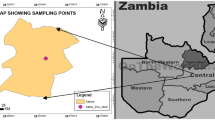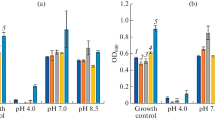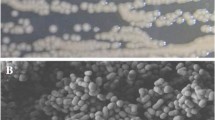Abstract
Uranium accumulation by a Pseudomonas strain was characterized in terms of kinetics, effect on cell viability and role of various regulatory factors (viz. pH, Co ions and metabolism). This strain was identified as Pseudomonas aeruginosa based on 16S rRNA gene and Fatty Acid Methyl Ester (FAME) analyses. The bacterium exhibited rapid, concentration and pH dependent, uranium accumulation with maximum loading of 275 mg uranium g−1 dry wt. at pH 4.0. Survival studies during the period of uranium exposure indicated a viable but non growing state of the cells. Uranium accumulation remains largely insensitive to metabolic activity and presence of other co-ions except Fe3+. Transmission electron microscopy (TEM) confirmed the deposition of bioaccumulated uranium by live cells within the cell envelope region. Our findings suggest that the P. aeruginosa J007 has intrinsic uranium-removal and -resistance properties. Accumulated uranium is deposited within the cell envelope region providing a possible survival strategy to the bacterium. Our study contributed significantly to gain insight into bacterial interaction with uranium and will be useful in understanding the role of native microorganisms inhabiting in uranium contaminated sites in biogeochemical cycling of uranium and in bioremediation applications.




Similar content being viewed by others
References
Akob DM, Mills HJ, Kostka JE (2007) Metabolically active microbial communities in uranium-contaminated subsurface sediments. FEMS Microbiol Ecol 59:95–107
Beazley MJ, Martinez RJ, Sobecky PA, Webb SM, Taillefert M (2007) Uranium biomineralization as a result of bacterial phosphatase activity: insights from bacterial isolates from a contaminated subsurface. Environ Sci Technol 41:5701–5707
Charles AL, Markich SJ, Stauber JL, De Filippis LF (2002) The effect of water hardness on the toxicity of uranium to a tropical freshwater alga Chlorella sp. Aquat Toxicol 60:61–73
Choudhary S, Sar P (2009) Characterization of a metal resistant Pseudomonas sp. isolated from uranium mine for its potential in heavy metal (Ni2+, Co2+, Cu2+, and Cd2+) sequestration. Bioresour Technol 100:2482–2492
Choudhary S, Sar P (2010) Uranium biomineralization by a metal resistant Pseudomonas aeruginosa strain isolated from contaminated mine waste. J Hazard Mater (in Press). Accepted manuscript doi:10.1016/j.jhazmat.2010.11.004
Francis AJ, Dodge CJ, Lu F, Halada GP, Clayton CR (1994) XPS and XANES studies of uranium reduction by Clostridium sp. Environ Sci Technol 28:636–639
Hillson NJ, Hu P, Andersen GL, Shapiro L (2007) Caulobacter crescentus as a whole-cell uranium biosensor. Appl Environ Microbiol 73:7615–7621
Hu MZC, Norman JM, Faison BD, Reeves M (1996) Biosorption of uranium by Pseudomonas aeruginosa strain CSU: characterization and comparison studies. Biotechnol Bioeng 51:237–247
Kelly SD, Kemner KM, Fein JB, Fowle DA, Boyanov MI, Bunker BA, Yee N (2002) X-ray absorption fine structure determination of pH dependent U-bacterial cell wall interactions. Geochim Cosmochim Acta 65:3855–3871
Lane D (1991) 16s/23s rRNA sequencing. In: Stackebrandt E, Goodfellow M (eds) Nucleic acid techniques in bacterial systematics. Wiley, United Kingdom, pp 115–175
Lloyd JR, Renshaw JC, May I, Livens FR, Burke IT, Mortimerc RJG, Morris K (2005) Biotransformation of radioactive waste: microbial reduction of actinides and fission products. J Nucl Radiochem Sci 6:17–20
Marquis AM, Roca X, Simon-Pujol MD, Carmen FM, Congregado F (1991) Uranium accumulation by Pseudomonas sp. EPS-5028. Appl Microbiol Biotechnol 35:406–410
Martinez RJ, Beazley MJ, Taillefert M, Arakaki AK, Skolnick J, Sobecky PA (2007) Aerobic uranium (VI) bioprecipitation by metal-resistant bacteria isolated from radionuclide-and metal-contaminated subsurface soils. Environ Microbiol 9:3122–3133
Merroun ML, Selenska-Pobell S (2008) Bacterial interactions with uranium: an environmental perspective. J Contam Hydrol 102:285–295
Moore E, Tindall B, Santos VMD, Pieper D, Ramos J, Palleroni N (2006) Nonmedical: Pseudomonas. In: Dworkin M, Falkow S, Rosenberg E, Schleifer KH, Stackebrandt E (eds) The prokaryotes: a handbook on the biology of bacteria, 3rd edn. Springer, New York, pp 646–703
Nedelkova M, Merroun ML, Rossberg A, Hennig C, Selenska-Pobell S (2007) Microbacterium isolates from the vicinity of a radioactive waste depository and their interactions with uranium. FEMS Microbiol Ecol 59:694–705
Sar P, D’Souza SF (2001) Biosorptive uranium uptake by a Pseudomonas strain: characterization and equilibrium studies. J Chem Technol Biotechnol 76:1286–1294
Stead DE (1992) Grouping of plant-pathogenic and some other Pseudomonas spp. by using cellular fatty acid profiles. Int J Syst Bacteriol 42:281–295
Strandberg GW, Shumate SE, Parrott JR (1981) Microbial cells as biosorbents for heavy metals: accumulation of uranium by Saccharomyces cerevisiae and Pseudomonas aeruginosa. Appl Environ Microbiol 41:237–245
Suzuki SY, Banfield JF (1999) Geomicrobiology of uranium. In: Burns PC, Finch R (eds) Uranium: mineralogy geochemistry and the environment. Mineralogical Society of America, Washington, pp 393–432
Suzuki SY, Banfield JF (2004) Resistance to, and accumulation of, uranium by bacteria from a uranium-contaminated. Geomicrobiol J 21:113–121
Tamura K, Dudley J, Nei M, Kumar S (2007) MEGA 4: molecular evolutionary genetics analysis (MEGA) software version 4.0. Mol Biol Evol. doi:10.1093/molbev/msm092
Yang J, Volesky B (1999) Biosorption of uranium on Sargassum biomass. Water Res 33:3357–3363
Acknowledgments
Sangeeta Choudhary gratefully acknowledges financial assistance received from University Grants Commission, India. Pinaki Sar gratefully acknowledges financial support received from BRNS, Department of Atomic Energy, India and from Council of Scientific and Industrial Research, India. Generous support from UCIL, Jaduguda and National Facility of Electron Microscopy at AIIMS, New Delhi is gratefully acknowledged.
Author information
Authors and Affiliations
Corresponding author
Electronic supplementary material
Below is the link to the electronic supplementary material.
Rights and permissions
About this article
Cite this article
Choudhary, S., Sar, P. Identification and characterization of uranium accumulation potential of a uranium mine isolated Pseudomonas strain. World J Microbiol Biotechnol 27, 1795–1801 (2011). https://doi.org/10.1007/s11274-010-0637-7
Received:
Accepted:
Published:
Issue Date:
DOI: https://doi.org/10.1007/s11274-010-0637-7




